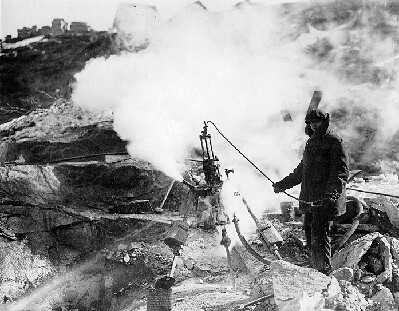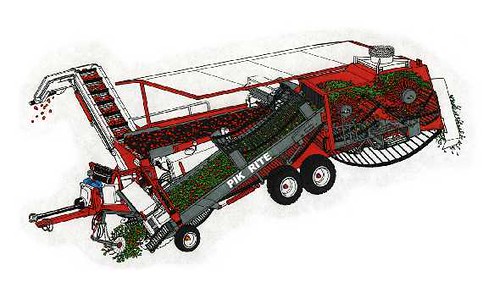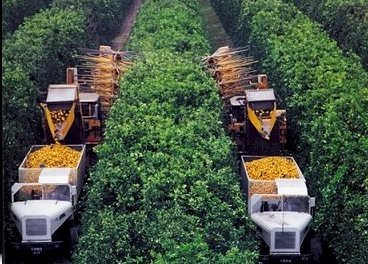John Henry he said to his captain:No one knows for sure who John Henry was, or even whether he really lived. He is such a popular figure in American folklore that generations of local storytellers and balladeers have claimed him across a wide swath of the southeastern United States -- continuing his memory, and at the same time obscuring his identity. According to John Garst at the University of Georgia, he might have been John Henry Dabney, born a slave in 1844 on Burleigh Plantation (near Crystal Springs Mississippi) and the much sung and storied contest between John Henry with his hammer and the steam drill may have taken place during the construction of the Oak and Coosa Mountain tunnels east of Birmingham for the C & W Railroad in 1887. That would make John Henry's 'captain' Captain Frederick Yeamans Dabney, a railroad engineer, Confederate veteran and nephew of John Henry's former owner.
"Your money is getting mighty slim,
When I hammer through this old mountain,
Oh Captain will you walk in?"
John Henry's captain came to him
With fifty dollars in his hand,
He laid his hand on his shoulder and said:
"This belongs to a steel driving man."
John Henry was hammering on the right side,
The big steam drill on the left,
Before that steam drill could beat him down,
He hammered his fool self to death.

Steam Drill
John Henry was a manual laborer who's job was being replaced by a machine. He was the last and best of his breed -- fighting a delaying action against inevitable changes that would make him obsolete. There are countless versions of the songs and stories about John Henry and they all have a common theme that if John Henry had been more sensible he wouldn't have "hammered his fool self to death," clinging to a way of life that was ending. If John Henry had been smarter he would have learned to work with that steam drill, but he loved the swing and the sing of his hammer too much. His one-time victory over the machine didn't change anything. If he had been smarter he would have done something else. But he didn't and we still sing about him almost a century later.
When the Bracero program ended in 1964 many argued that the tomato industry in California would be damaged, or at least that the prices of tomato products such as ketchup would soar. What happened instead was that the industry developed a new variety of tomatoes with an oblong fruit that was sturdier and capable of machine harvesting. Picking tomatoes was the "job Americans won't do" of its day in the early 1960s. Then as now the idea of "jobs Americans won't do" stinks if you consider it as an attitude of the American work force. But as a statement of economic reality, or as a prediction, it was spot on. The guest worker program ended and Americans never did that job. The Braceros were replaced by machines.

Tomato Harvester -- The Steam Drill of 1964
Like John Henry who drilled blasting holes with a steel drill and a big hammer, the Braceros who picked tomatoes in California were working in a labor-intensive job where nascent advances in technology put a ceiling on how much it made sense to pay for the work they did. By the time the Bracero program ended their labor was still cost-effective for their employers -- due in large part to the fact that the Braceros worked insanely hard for very little pay -- but the handwriting was on the wall. It wouldn't have been long before the improvements in mechanized agriculture would have made the hand-picking of tomatoes uneconomic, at least for making ketchup, even with Bracero labor. The industry adapted to the loss of the migrant laborers with scarcely a pause.
The story of the Braceros in California does not lend itself to songs like John Henry, the Steel Drivin' Man, but it is a story often told by anti-immigration pundits who see it as a refutation of the idea that the economy needs immigrant labor to perform labor-intensive tasks that are uneconomic if done at the local prevailing labor rate. And since the end of the guest worker program was, for the most part a wash for the California tomato industry and labor market, it does tend to contradict those who predict huge dire consequences if the supply of cheap labor is cut off.
On the other hand there was very little good that came from ending the program either. The companies growing tomatoes in California were forced to invest in mechanization a bit earlier than they would have otherwise. Non-immigrant agricultural workers in California saw a small increase in the level of pay they could demand but not enough to really change their situation. The jobs vacated by the Mexican workers did not go to higher-paid American workers -- the jobs just went away when the guest workers did. So the end of the Bracero program in 1964 was slightly favorable for farm workers in California unless they owned their own farm. It was slightly unfavorable for farm owners -- being least painful to the large farm owners who could afford to mechanize and most painful for the smaller farmers who could could not. On the whole, as I said, it was a wash... as long as you forget about the Braceros themselves. For them it was a disaster.
It cannot be denied that the Braceros were not treated very well. They worked hard, often in very bad conditions, and were paid very little. It says a lot about their conditions back home that they would queue up by the thousands to be treated so badly. The fact of the matter is that however lousy their pay was by American standards it allowed them to support their families far better than they could by working in Mexico.
Today's Informal Guest Worker Program:
The Mexican economy tanked in December 1994 when the Mexican government could no longer support the increasingly unrealistic valuation of the Peso. The banking system collapsed and the country was thrown into a depression. In the more developed parts of the country eventual recovery was made possible by an emergency loan from the United States and by the NAFTA free trade agreement that stimulated Mexican industry and boosted exports. In the poorer parts of the country the poverty rate exceeded 50 percent for years and finally dropped mostly due to money that men who were working illegally in the US sent home to their families. The number of illegal immigrants currently working in the US is estimated at approximately twelve million and the money they send home is the second-largest source of revenue for the Mexican economy.
Like the Braceros, today's illegal immigrants are largely agricultural workers. Unlike their predecessors who were seasonal workers, today's illegal immigrants tend to remain in the country all year. Those who see immigration as a threat often point out that when the season is over the seasonal workers no longer go home. While this could indicate that they have lost their desire to return home during the off season, it could also reflect the fact that increased patrolling of the border forces them to choose between spending the off season with their families and being sure they will be able to work during the next year's growing season.
They continue to work in areas where the American workforce has moved on. It's not so much the jobs that Americans won't do as jobs Americans used to do but don't any more. Much of the citrus that is grown in this country is picked by immigrant labor. American's don't mind picking fruit. We used to pick fruit but, with international competition being what it is, and with emerging technology for picking the fruit mechanically holding down the value of the labor, it doesn't pay very well. And if the immigrants were to disappear it wouldn't pay at all. The job of picking oranges would quickly be done by machines.

Citrus Harvesting Machines -- the Steam Drill of the new millennium.
You shouldn't think that I am suggesting that the citrus-picking machines will put low-cost immigrant workers out of work. There is always something useful that hard-working, low-cost labor can do. I remember talking to a forester about growing pine trees in the Florida panhandle. After you harvest a plantation of trees there are three things you can do to get ready for the next cycle. Two of the three operations cost money but they improve your yield per acre. For option one you do nothing but leave a few seed trees per acre. With option one you can expect a yield of about thirty-five dollars per acre per year on average. Option two adds a controlled burn and sending in a team after the first year to kill any sprouting hardwoods so they don't crowd out the young pine trees. With option two you get another fifteen to twenty dollars an acre. Option three is doing the whole thing with machines to grind stumps and prepare the soil and a v-groove planter. Option three is quite expensive but you can get over one hundred dollars a year per acre. If you are a paper company and can spread the cost of the machines over thousands of acres there is no question that the last option is the most profitable. If you have an acre or two it is probably most sensible just to rely on the seed trees since the benefit of site preparation is so small with so few acres. But if you fall at just the right spot in the middle of the range the forester I was talking with can hook you up with a team of Guatemalans who can make their living on that fifteen dollar per acre spread between options one and two.
In the admittedly unlikely event that you are terribly interested in site preparation options for southern pine plantations, you might want to read this

No comments:
Post a Comment